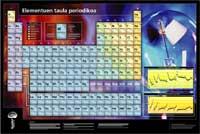Names II

They were important times of discovery of chemistry and, as for the elements, very abundant. In fact, in that century and in the previous one, most of the elements currently included in the periodic table were discovered, isolated or identified: XVIII. In the early nineteenth century 15 elements were known. At the end of the 84 century.
When Berzelius proposed how to express the elements, the list of elements was greater than 50 and used rather complex and dark symbologies to represent them: some based on astrology or cabalistic signs, others more rational, but all without much standardization. The demand for a systematic was already made and the program was also made, but the success was Berzelius. He proposed a simple and easy to use system that we all know. As a symbol he used the first letter of the name of each element and, when repeated, added a second letter. That is why they are boron B, barium Ba or bismuth Bi.
In addition to its simplicity, in most cases, the system proposed by Berzelius is able to establish a relationship between the symbol and the element without difficulties. But not always. Sometimes the relationship between the name and the symbol is little or no obvious, more or less frequent depending on the language. These difficulties are the result of one of the measures to combat inequalities between languages. In order to identify elements to be spoken in different languages, Berzelius generally relied on the Latin names of the elements as the basis for fixing the symbols, and therefore are silver Ag ( argentum), lead Pb ( from plumbum) or gold Au ( from aurum). Therefore, those who speak languages from Latin have an advantage with the 'logic' of certain symbols, since in few cases there are not many more examples of this type.

These examples include mercury. In fact, the fact that the language is Latin does not help to relate symbol and name. The symbol corresponding to the element mercury is Hg, produced from the name of hydrargyros (silver water), adapted from Greek to Latin. But what is the relationship between hydrargyos and mercury? Well alchemy. It can be said that mercury is the memory that medieval alchemists have left on the periodic table. At that time seven elements were known (iron, copper, tin, silver, gold, mercury and lead) and seven planets (including the Moon, from Mercury to Saturn), and the alchemists called each element, according to them, a planet based on its nature. This use has left a mark on expressions, so it has been called lead saturnism poisoning. But the only thing that has survived as an element name has been mercury, which is the end of the alchemist legacy.
What has not completely ended is the freedom to sign up for those found. There are basic rules and XX. Since the middle of the century IUPAC has the capacity to decide on names, a reference entity in the field of chemistry, but the group or person who finds it (or rather, the one who synthesizes it, since all new elements are created artificially) has the right to propose a name. In their day they were named according to the discoverer's fantasy, its properties or, often, the name of the mineral that was isolated. Subsequently, names of places, regions or nations, planets, or scientists have also been used, and today, following tradition, proposals are made along the same path.
Published in Berria
Buletina
Bidali zure helbide elektronikoa eta jaso asteroko buletina zure sarrera-ontzian











